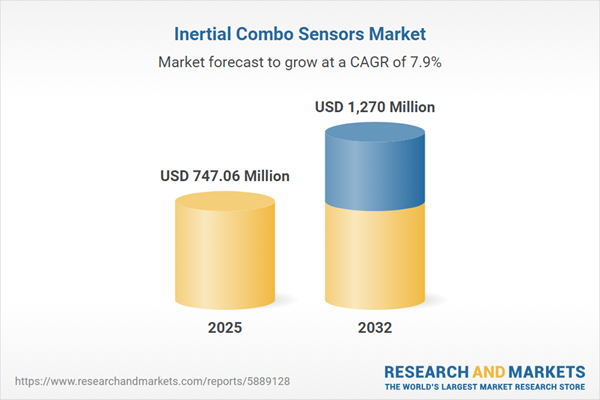Speak directly to the analyst to clarify any post sales queries you may have.
The inertial combo sensors market is experiencing robust growth driven by accelerated innovation, expanding applications, and increased adoption across industries. Senior leaders seeking informed decisions on technology investments and sourcing strategies will find actionable insights and practical perspectives within this research.
Market Snapshot: Inertial Combo Sensors Market Performance and Growth Trajectory
The inertial combo sensors market grew from USD 692.59 million in 2024 to USD 747.06 million in 2025, and is projected to continue expanding at a CAGR of 7.92% to reach USD 1.27 billion by 2032.
This pace reflects strong demand across aerospace, automotive, consumer electronics, healthcare, and industrial applications, coupled with technological advancements in microelectromechanical systems (MEMS) and sensor fusion.Scope & Segmentation: Industry Coverage and Market Structure
- Application Areas: Aerospace & defense (navigation systems, surveillance and reconnaissance), automotive (advanced driver assistance, navigation and safety), consumer electronics (gaming consoles, smartphones, tablets, wearables), healthcare (medical robotics, patient monitoring), industrial (drones & UAVs, machine automation, robotics & automation).
- Sensor Configuration: 6-axis multi-chip modules, 6-axis single chip, 9-axis multi-chip modules, 9-axis single chip.
- Technology Types: MEMS (with capacitive and piezoelectric MEMS), fiber optic, hemispherical resonator gyroscopes, quartz tuning fork gyroscopes.
- Distribution Channels: Aftermarket (serving automotive, consumer electronics, industrial sectors), OEM (original equipment manufacturers across these industries).
- Packaging Formats: Bare die, packaged die, board-level modules, chipset modules.
- Geographic Regions: Americas (United States, Canada, Mexico, Brazil, Argentina, Chile, Colombia, Peru), EMEA (Europe, Middle East, Africa—UK, Germany, France, Russia, Italy, Spain, Netherlands, Sweden, Poland, Switzerland, UAE, Saudi Arabia, Qatar, Turkey, Israel, South Africa, Nigeria, Egypt, Kenya), Asia-Pacific (China, India, Japan, Australia, South Korea, Indonesia, Thailand, Malaysia, Singapore, Taiwan).
- Leading Companies: STMicroelectronics International N.V., Bosch Sensortec GmbH, InvenSense, Inc., Analog Devices, Inc., Kionix, Inc., NXP Semiconductors N.V., Murata Manufacturing Co., Ltd., Sensonor AS, Seiko Epson Corporation, Silicon Sensing Systems Ltd.
Key Takeaways for Senior Decision-Makers
- Integration of accelerometers and gyroscopes in compact form factors is enabling novel applications and supporting platform miniaturization across several sectors.
- Emerging hybrid architectures and embedded machine learning features are refining precision, reducing noise, and unlocking new autonomous system capabilities.
- End-market demand is shifting with increased emphasis on operational reliability under extreme and variable conditions, particularly in aerospace, defense, and industrial automation.
- Regional strategies must adapt to local certification standards, government incentives, and consumer price sensitivity, especially in Asia-Pacific and EMEA.
- Partnerships with academic and industrial partners accelerate product innovation, especially as system-on-chip and sensor fusion become central to achieving next-generation performance.
- Acquisitions and vendor diversification are emerging as key strategies for scaling and mitigating supply chain risks in an evolving market landscape.
Tariff Impact: Navigating U.S. Policy Shifts and Sourcing Strategies
New U.S. tariff measures introduced in early 2025 have increased input costs for critical semiconductor components and sensor assemblies. Suppliers are responding with nearshoring, vendor diversification, and long-term partnering to stabilize supply and preserve margins. Contract renegotiations and localized manufacturing are shaping cost structures and strategic sourcing decisions across the value chain.
Methodology & Data Sources
This research combines extensive primary interviews with module designers, OEMs, system integrators, and stakeholders, with a breadth of secondary sources including patent analysis and industry reports. Findings are validated through data triangulation and expert panel review, ensuring credible and actionable insights specific to the inertial combo sensors market.
Why This Report Matters
- Supports C-suite and procurement leaders in navigating technology advancement, global sourcing, and tariff-related cost challenges.
- Highlights best practices for innovation, risk mitigation, and regulatory compliance tailored to each industrial vertical and region.
- Offers granular segmentation and regional perspectives to guide market prioritization, investment, and product development strategies.
Conclusion
This report empowers senior leaders to align strategy, sourcing, and innovation efforts in a rapidly evolving inertial combo sensors market. Informed decision-making positions organizations to address risk, optimize value, and unlock growth potential in dynamic global contexts.
Additional Product Information:
- Purchase of this report includes 1 year online access with quarterly updates.
- This report can be updated on request. Please contact our Customer Experience team using the Ask a Question widget on our website.
Table of Contents
3. Executive Summary
4. Market Overview
7. Cumulative Impact of Artificial Intelligence 2025
Companies Mentioned
The companies profiled in this Inertial Combo Sensors market report include:- STMicroelectronics International N.V.
- Bosch Sensortec GmbH
- InvenSense, Inc.
- Analog Devices, Inc.
- Kionix, Inc.
- NXP Semiconductors N.V.
- Murata Manufacturing Co., Ltd.
- Sensonor AS
- Seiko Epson Corporation
- Silicon Sensing Systems Ltd.
Table Information
| Report Attribute | Details |
|---|---|
| No. of Pages | 183 |
| Published | October 2025 |
| Forecast Period | 2025 - 2032 |
| Estimated Market Value ( USD | $ 747.06 Million |
| Forecasted Market Value ( USD | $ 1270 Million |
| Compound Annual Growth Rate | 7.9% |
| Regions Covered | Global |
| No. of Companies Mentioned | 11 |









